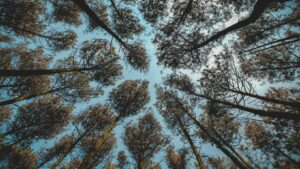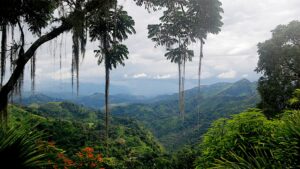Capturing the essence of the forest through a lens is an art that combines patience, skill, and a deep appreciation for nature’s intricate beauty. Forest landscape photography invites viewers into a world where light and shadow dance among ancient trees, where mist weaves through branches creating ethereal scenes, and where every leaf tells a story of survival and growth. It’s not just about taking pictures; it’s about conveying the soul of the forest.
Forest Landscape Photography
The Allure of the Forest
Forest landscape photography captures the inherent beauty and the serene essence of forests, drawing photographers and viewers into a world of undisturbed tranquility. The allure lies in the diverse textures, colors, and forms found within the forest landscape, from the intricate patterns of leaves and bark to the dynamic interplay of light and shadow. These elements, when skillfully captured, create compelling images that evoke a deep sense of connection with nature. The ever-changing conditions in a forest, including seasonal transformations and varying light conditions throughout the day, offer photographers endless opportunities for creativity and exploration. Each forest scene holds a unique story, waiting to be told through the lens of a camera.
Key Challenges Photographers Face
 Despite the allure, forest landscape photography presents several challenges that photographers must navigate. Firstly, the complexity of the forest environment can be overwhelming, with the dense arrangement of trees, underbrush, and irregular light creating busy and sometimes cluttered compositions. Finding coherence in the chaos requires a keen eye for framing and composition to isolate subjects or patterns that embody the spirit of the forest. Secondly, lighting in forests is notoriously difficult to master due to the canopy cover, which causes high contrast scenes especially on sunny days. Photographers often have to adapt quickly to the changing light conditions, harnessing moments of soft, diffused light that best accentuate the forest’s features. Lastly, accessibility and environmental conditions can pose significant challenges, from navigating rough terrains to dealing with unpredictable weather, all of which demand patience, persistence, and a profound respect for the natural environment.
Despite the allure, forest landscape photography presents several challenges that photographers must navigate. Firstly, the complexity of the forest environment can be overwhelming, with the dense arrangement of trees, underbrush, and irregular light creating busy and sometimes cluttered compositions. Finding coherence in the chaos requires a keen eye for framing and composition to isolate subjects or patterns that embody the spirit of the forest. Secondly, lighting in forests is notoriously difficult to master due to the canopy cover, which causes high contrast scenes especially on sunny days. Photographers often have to adapt quickly to the changing light conditions, harnessing moments of soft, diffused light that best accentuate the forest’s features. Lastly, accessibility and environmental conditions can pose significant challenges, from navigating rough terrains to dealing with unpredictable weather, all of which demand patience, persistence, and a profound respect for the natural environment.
Essential Gear for Capturing the Forest
To excel in forest landscape photography, possessing the right gear is paramount. Crossing the bridge between capturing a moment and embodying the forest’s soul lies in the selection of equipment tailored for this unique challenge.
Cameras
Selecting a camera that offers a high dynamic range proves crucial in managing the varied lighting conditions found within forests. DSLR and mirrorless cameras, known for their adaptability and quality, stand as the top choices. They provide the flexibility needed to capture the vivid contrasts and subtle details of the forest landscape.
Lenses
A variety of lenses can enhance the forest photography experience. Wide-angle lenses, for instance, are ideal for capturing expansive forest vistas or emphasizing the grandeur of towering trees. On the other hand, macro lenses allow photographers to delve into the minute beauty of forest details, such as dew on leaves or intricate patterns on bark.
Accessories
 Tripods and remote shutter releases are indispensable accessories for forest landscape photography. They aid in stabilizing the camera for sharp images, especially in low-light conditions or during long exposure shots. Additionally, polarizing filters can significantly reduce reflections and enhance the natural colors of the forest, making them a valuable addition to any photographer’s toolkit.
Tripods and remote shutter releases are indispensable accessories for forest landscape photography. They aid in stabilizing the camera for sharp images, especially in low-light conditions or during long exposure shots. Additionally, polarizing filters can significantly reduce reflections and enhance the natural colors of the forest, making them a valuable addition to any photographer’s toolkit.
Mastering forest landscape photography demands more than just skill and patience; it requires the right gear to truly capture the essence of the forest. With the appropriate camera, lenses, and accessories, photographers can overcome the challenges posed by the complex forest environment and produce breathtaking images that reflect the beauty and serenity of nature.
Composition Techniques in Forest Photography
Leading Lines
Leading lines guide the viewer’s eye through the photograph, creating a sense of depth and perspective. In forests, paths, streams, or arranged trees serve as natural leading lines, directing attention towards the main subject or vanishing point. Additionally, video editing tools can enhance these leading lines to emphasize depth and perspective even further.
Rule of Thirds
Applying the rule of thirds involves dividing the image into nine equal segments by two vertical and two horizontal lines. Placing the key elements of the forest scene along these lines or their intersections enhances the photo’s balance and invites viewers to engage with the image more naturally.


